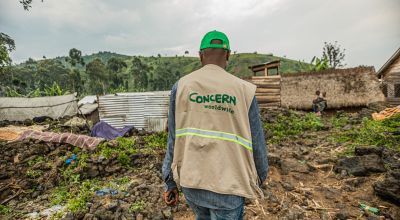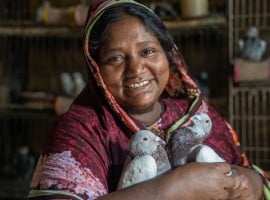
Read our 2024 annual report

Knowledge Hub
Foreign assistance is a key component for NGOs like Concern. Fortunately, Ireland ranks number one in 2019 and 2020 for the most effective aid programme in the Principled Aid Index.
In Ireland, our foreign assistance comes chiefly from Irish Aid, the national overseas development programme. You may know that this organisation is funded by the Irish taxpayer. But have you ever wondered about what your tax actually does? Here’s how foreign assistance through Irish Aid works, as well as which countries get the most funding, and what we at Concern are doing with our share of grant funding.
What is foreign assistance?
Broadly speaking, the term “foreign assistance” refers to anything that one country gives for the benefit of another country. Usually, this means higher-income countries providing development assistance to lower- and middle-income countries. This assistance includes money, but can also be provided in the form of in-kind donations of goods or services. Some of these goods and services include:
- Food aid and distribution
- Education
- Water, sanitation, and hygiene initiatives
- Infrastructure assistance
- Agriculture training
- Climate resilience support
- Peace-building activities
- Health care
The goal with all of these forms of international aid is to maintain a functioning global society.
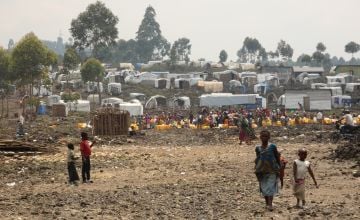
How foreign assistance works in Ireland
What we now know as Irish foreign assistance is actually younger than Concern Worldwide. Fifty-five years after the creation of the Department of Foreign Affairs in 1919, the DFA announced its first outline for an official foreign aid programme in 1974. Development Cooperation is now one of the 13 divisions and units of the DFA.
Irish Aid also responds to humanitarian crises, with the RRC (Rapid Response Corps) working alongside organisations like the UNHCR, World Food Programme, UN OCHA, UNICEF, and Concern Worldwide.
Ireland’s overseas development assistance programme is consistently ranked as one of the highest quality programmes in the world, and is something that Irish people are rightly proud of.
Irish Aid meets many different kinds of needs
As part of the Irish government’s commitment towards achieving the United Nations’ Sustainable Development Goals, Irish Aid’s priority areas for Official Development Assistance (ODA) include the following.
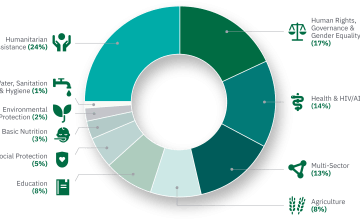
Each of these areas is linked to or seen as a key cause of poverty.
Irish Aid is rooted in a three-pronged vision for development cooperation
Irish Aid has codified the government’s policy towards international assistance and development in A Better World. This document charts how the government will achieve its UN target of allocating 0.7% of our GNI to official foreign assistance by 2030. It also provides more information on the core vision for Irish Aid, which comprises three values:
Equality
Irish foreign policy is rooted in the belief that zero poverty, zero hunger, and the advancement of human rights are the core bases for global equity, peace and sustainable development.
Sustainability
As Irish Aid puts it: “A sustainable world requires the protection of our natural world.” That means Irish foreign assistance is committed to being sustainable and supporting partner countries to achieve climate resilience and sustainable resource management.
Peace
Again, Irish Aid puts it best: “A secure stable world where people can live without fear and in dignity is the foundation for peace and the protection of people.”
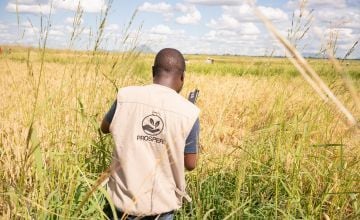
How much does Ireland spend on foreign assistance?
Last year, the government spent over €867.5 million on Ireland’s Official Development Assistance (ODA) programme. This represents just over 0.3% of the GNP, meaning that €0.31 out of every €100 goes towards foreign assistance. In October of 2021, the government announced a €140 million increase in overseas development assistance for next year, bringing the total budget to over €1 billion for the first time.
The increase comes at a very challenging time with 41 million people in 43 countries currently at risk of dying from hunger.
Irish foreign assistance can be either bilateral or multilateral, meaning funding that either goes directly into low- and middle-income countries (bilateral) or funding that supports international agencies (multilateral). In 2020, 53% of funding went to bilateral partners, while 47% went to multilateral partners.
Which countries received the most from Irish Aid?
Irish Aid lists its top ten partner countries for 2020 as:
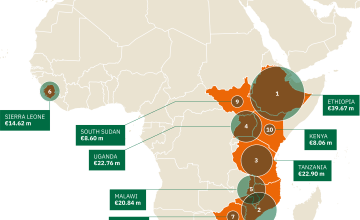
It’s important to note that foreign assistance does not constitute a “blank cheque” for any country. Irish Aid is accountable to the Irish people for its management of Ireland’s ODA funding. The organisation is managed in turn by Oireachtas Foreign Affairs Committee, the Public Accounts Committee and the DFA. Projects funded by Irish Aid are also audited and evaluated during and after their completion, to ensure that funds are well-spent and well-managed.
If you’re an Irish taxpayer, you also have the right to know how your contributions to Irish foreign assistance are being spent, which is why Irish Aid publishes extensive annual reports.
How Concern works with Irish Aid
Concern has a proud and successful history of working with the Irish government towards our shared aim of tackling extreme poverty.
In 2017, we received a five-year development grant from Irish Aid. The grant funds emergency and development programmes in 17 of the 24 countries where we work: Afghanistan, Bangladesh, Burundi, Central African Republic, Chad, Democratic People’s Republic of Korea, Democratic Republic of Congo, Ethiopia, Haiti, Liberia, Malawi, Niger, Rwanda, Sierra Leone, Somalia, South Sudan, and Sudan. Irish Aid also supports two separate programmes run by Concern in Ireland: Active Citizenship and Public Engagement.
We previously received a separate five-year development grant of €100 million from Irish Aid in 2012. This funding supported the implementation of 29 programmes, which collectively improved the lives of 1.3 million people in 19 countries. You can see how those programmes measured up year-over-year from 2012 to 2016 with our interactive Irish Aid Map.

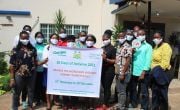
Your Concern — and foreign assistance — in action
In the last few years, Irish Aid has made many of Concern’s initiatives possible. Some of these include:
- Distributing food (wheat and lentils) and essential household items (cooking pots and utensils, soap, towels, and detergent) to support 5,000 displaced people in Ethiopia
- Transporting essential non-food items including tarpaulin, mosquito nets, soap, towels, and solar lights to 52,000 newly-arrived Ethiopian refugees displaced in Sudan
- Responding to winter camp flooding among Syrian refugees living in informal tented communities in Lebanon, providing new tents, repair kids, roofing material, mattresses, blankets, cooking sets, nappies, menstrual pads, soap, and other essentials
- Providing hot meals, as well as shelter and psychosocial support, to some of the 61,000 people impacted by the devastating fire that tore through the vast Rohingya refugee camp in Cox’s Bazar, Bangladesh
- Concern’s COVID-19 response in Sierra Leone, including contributing to the national effort to increase awareness of risks and other information on the novel coronavirus; supporting quarantine facilities, emergency operation committees, and community care centres; and supporting quarantined households and the most vulnerable communities to mitigate the impact of the pandemic on food security, livelihoods, and general well-being
- Strengthening Sustainability in Schools and Communities, a project in Liberia aimed to develop a strategy that addresses child stunting in a holistic, integrated, and sustainable manner. This programme involves three members of the Liberia WASH Consortium (Action Against Hunger, Concern Worldwide and Water Aid).
Find out more about what we do




